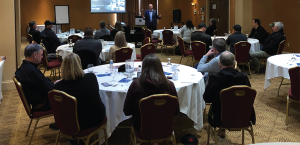The global supply chain disruption is one of the major challenges affecting the automotive aftermarket industry. Sylvain Seguin advises how shops can plan ahead to prepare for the inevitable.
By SYLVAIN SEGUIN
A great deal of newsprint has been used over the past two years highlighting how the current supply chain problem is disrupting businesses globally. I am not speaking only about major multinationals being affected, but also small and medium entrepreneurs, whose daily operations have almost come to a standstill. Without a doubt, it is a real test of nerves. While the aftermarket industry was largely resilient to the economic uncertainty surrounding the COVID-19 pandemic, the ensuing after-effects are now proving to be major headaches for the industry, and it is unlikely that a long-term solution will be found any time soon.
There are lots of challenges associated with running businesses these days – from the global supply chain disruption to possible large increases in logistical costs, unprecedented consumer demand, and ongoing turmoil in the markets providing critical raw materials for automotive components. Those challenges also affect the automotive aftermarket business, an essential service that needs to keep running all the time.
The aftermarket industry sources raw materials for components and other critical items from different countries. Over time, that supply has been squeezed, leading to longer delays. For example, the difficulty in procuring a semiconductor chip (typically costs between $5 and $15) has brought the automotive industry to its knees. The same is the situation with almost everything associated with the business – from EV batteries to paint solutions, from urethane for windshields to sheet metal and other parts for electrical components.

In its latest Fall 2022 “State of the Industry” Report, released recently, the Specialty Equipment Market Association (SEMA) points out that inflation and supply chain issues are raising costs for the industry. SEMA’s survey of more than 1,900 industry stakeholders concluded that there hasn’t been any significant drop in business despite the current operating climate.
I share your concern about the ongoing business environment – almost everyone has been affected in some way or the other. The silver lining though is that there are important discussions taking place across Canada and the globe to resolve the issue. At Fix Network, we are speaking to almost every stakeholder across the industry to identify pain points and propose solutions. Our industry-wide engagement includes everyone – from parts suppliers to insurance providers, from paint manufacturers to lawmakers, industry bodies and franchisees.
Collision repair is a tough business, and shops always look to manage their operations efficiently, with minimum cost and maximum returns. As the industry looks for workable solutions, here are some ways how you can manage the current challenges for your shop:
Set realistic expectations on deadlines: Most customers are aware of the supply chain issues taking place around the world and understand your challenges. However, it’s best to advise them about impending delays if you are waiting on spare parts or any specialty items.
Train your staff: Customer service teams – the first point of contact with the customer – should be trained with the right relationship management skills and be as transparent as possible with clients to give them a complete picture of the situation. The teams should be trained to understand the client requirements and always communicate clearly, especially if there are any foreseeable delays. We need to remember that we are an essential business and that we are in the customer service business.
Collaborate closely: This will also be a good time for you to work proactively with your team and with suppliers to address immediate priorities. Engage with multiple suppliers if necessary.
Monitor the situation regularly: There is no clear picture of when the situation will improve but it’s best to look at the ongoing trends and developments with advice from your peers or organizations like Fix Network, to understand any developments that may impact your business.
Order efficiently: This will be perhaps the right time for you to combine cost-efficiency with profitability. Ensure that you have enough of the right components, accessories and materials, without the risk of over-stocking. Having more items in your inventory than necessary may leave you burdened with items that you don’t need when the situation improves.
As we close the year with an ambition to remain resilient, let’s hope and pray that the coming year brings in more opportunities for all of us to survive those challenges.
Sylvain Seguin is President of Fix Network (Canada).





































